Contents (Jump to a section)
How to Release Tight Calves: Massage & Stretching for Fast Tension Relief

- What Causes Tight Calves?
- Why You Need to Learn How to Release Tight Calves
- How to Release Tight Calves: Massage, Stretching, & Other Recovery Efforts
-
Best Calf Stretches to Release Tight Calves
- 4.1 Downward Dog
- 4.2 Lunge Stretch
- 4.3 Heel Drop
- 4.4 Standing Bent-Over Calf Stretch
- 4.5 Wall Calf Stretch
- 4.6 Soleus Stretch
- Follow Up With Strategic Stretching
- How Long Does it Take Calf Tightness to Go Away?
- How Tight Calves Affect the Body
- Preventing Tight Calves
- Final Thoughts on How to Release Tight Calves
Suffering from tight calves that cramp and are constantly sore is not a pleasant experience. That’s why we’re here to teach you how to release tight calves so that you can obtain blissful relief!
Various causes of tight calves, like overuse, can result in painful symptoms like restrictive movement and cramping. Finding relief from tight calf muscles is obtainable through approaches like deep tissue work that target the fascia and muscles. But what method for releasing tight calves is the most effective?
Throughout this article, we will teach you why releasing tight calves is essential and how to proactively release tension in the calves with practical methods and tools.
What Causes Tight Calves?
Before going into the causes of tight calves, let’s discuss what " tightness " is in the muscles, in this case, the calves. When a person experiences tightness in muscles, they experience muscle rigidity, which translates to the inability to relax the muscles, which can result in cramping or pain. The tightness in the muscles is due to the muscle being unable to achieve its full range of motion resulting in a semi-contracted state where the muscle cannot lengthen or relax.
Tightness in the calves is, more often than not, caused by overuse of the muscles. This can be instigated by activities like running, playing sports, or exercising. Or even simply participating in a repetitive activity like running can cause the calves to tighten up. On the other hand, underusing the calves can also result in stiffness, or even standing up all day, as the muscles will acclimate to being in a lengthened position.
A less common reason for tight calves is deep vein thrombosis (DVT). This medical condition occurs when a blood clot, or thrombus, forms in the body's deep veins, usually in the legs. When this happens, the area of the clot can become painful, sore, or tight. Deep vein thrombosis is a severe medical condition as the clot can travel to the lungs.
Medications can have side effects that result in soreness, tightness, cramping, or pain in the muscles. Clonazepam and metformin are examples of such. There are also conditions like myopathy and neurologic disorders that can result in muscle stiffness as a side effect.
Why You Need to Learn How to Release Tight Calves
Releasing tight calves can benefit you in ultimately providing pain relief. However, not addressing tight calves can lead to serious repercussions. A study presented the negative effects calf tightness has on balance and gait ability, which can cause imbalances in the muscles, joints, and tendons in other parts of the body.
Not addressing tight calves can also continue to create mobility restrictions that can inhibit day-to-day activities and increase the risk of injury in the future. For example, when the calves are tight, it can restrict the range of motion in the ankles. These mobility issues can result in a balance shift to the front of the foot. This can lead to painful problems like nerve entrapment and bursitis, a painful inflammation in the bursa that acts as a cushion between bones and tendons.
By taking time to address your tight calves, you are reducing the risk of these issues caused by stiff calf muscles.
How to Release Tight Calves: Massage, Stretching, & Other Recovery Efforts
There are various effective methods to consider for releasing tight calves, including massages and stretching. To learn more about how to reduce tension in tight calves and gain pain relief, continue reading!
Start by Warming the Muscles Up
A practical method of reducing tightness in the calves, especially pre- or post-exercise, is warming the muscles up.
When the muscles are warm, they are more pliable and prone to increased flexibility. When the muscles are cold, it produces the opposite effect. This is why warming the muscles up is vital before exercising, as injury risk is significantly reduced since warm muscles are more in tune to adapting to load and stress.
To warm up the muscles before exercise, mobility work is the most efficient method as it warms up the muscles and the joints to prepare for dedicated forms of movement used during the training session. Some ways to warm up the muscles, in general, include using a heating pad, hot tub, or sauna, which can be used post-exercise to decrease muscle tension.
Deep Tissue Work to Eliminate Restrictions
The body's deeper tissues are the fascia, connective tissue that works as an internal structure for the body, and muscles. When these two tense up, painful issues like cramping, tightness, and soreness, ensue.
With deep tissue work, the tight fascia and muscles are addressed to relieve tension and improve circulation in the area. Some commonly used methods of deep tissue work can be achieved through deep tissue massages done by a massage therapist or with easy-to-use at-home tools like a lacrosse or tennis ball, foam rolling, and mobility stick. For learning how to release tight calves with massage work, pressure is needed to encourage the muscles to relax.
To work tight calves, you must apply pressure in the area. When you find more tender spots, increased pressure should be applied. These tender spots are the “problem” areas and need to be addressed to find relief.
You can place the foam roller underneath your calves in a seated position. Next, place your arms behind your back to lift your butt off the floor to apply added weight and pressure to the calves. Next, gently and slowly roll back and forth to release tension. This method can also be used with a lacrosse or tennis ball to apply pressure in different directions for added relief.
As calf tightness can often start from the feet, from issues like plantar fasciitis, using a lacrosse ball can be an applicable method to using deep tissue work to target this issue. Using the lacrosse or tennis ball, place it under the arch of your foot. Add desired pressure by driving your foot down into the ball as you roll back and forth, then side to side. This deep tissue work can be perfect for relieving pain associated with plantar fasciitis, which can result in calf tightness.
Best Calf Stretches to Release Tight Calves
If you find your calf muscles are feeling tight, introducing regular stretching into your routine can be beneficial. Consider performing the following stretches every day, and you might want to start by stretching twice daily. This approach can help extend the muscle fibres and may reduce the discomfort you're feeling.
Downward Dog
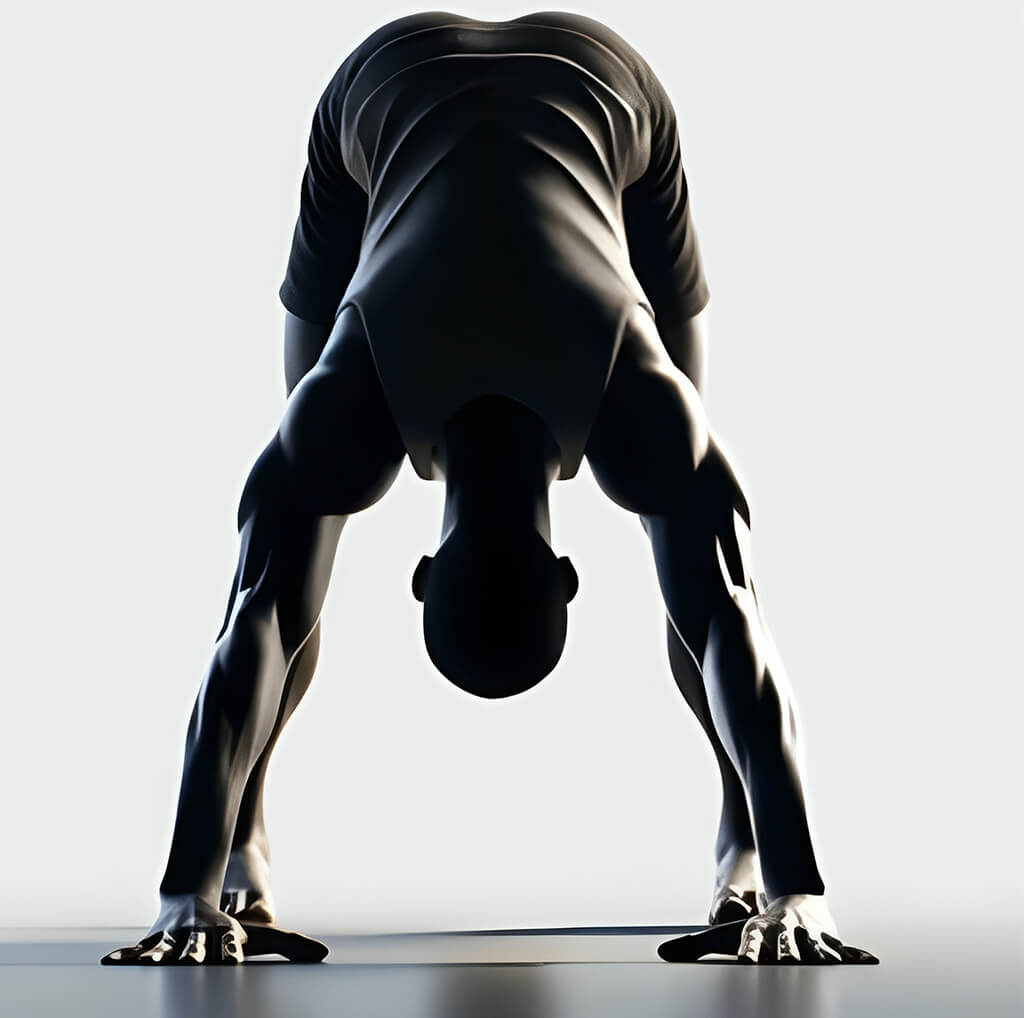
Start on your hands and knees, lift your hips towards the ceiling, and straighten your legs. This stretches the calves and hamstrings.
- Step 1: Kneel on your hands and knees, with your hands under your shoulders and your knees under your hips. Your back should be flat like a tabletop.
- Step 2: Curl your toes under and press your palms into the floor.
- Step 3: Exhale as you lift your knees and raise your hips toward the ceiling.
- Step 4: Straighten your legs without locking your knees. And press your heels toward the floor. (It's OK if your heels don't touch the floor.) Your body should form an upside-down V shape, with your chest facing your thighs.
- Step 5: Inhale as you draw your belly button in toward your spine. Keep your neck and spine neutral and your gaze directed toward your feet.
- Step 6: Hold this calf stretch for 30 seconds.
- Step 7: Bend your knees, release the pose, and return to the starting position.
Lunge Stretch
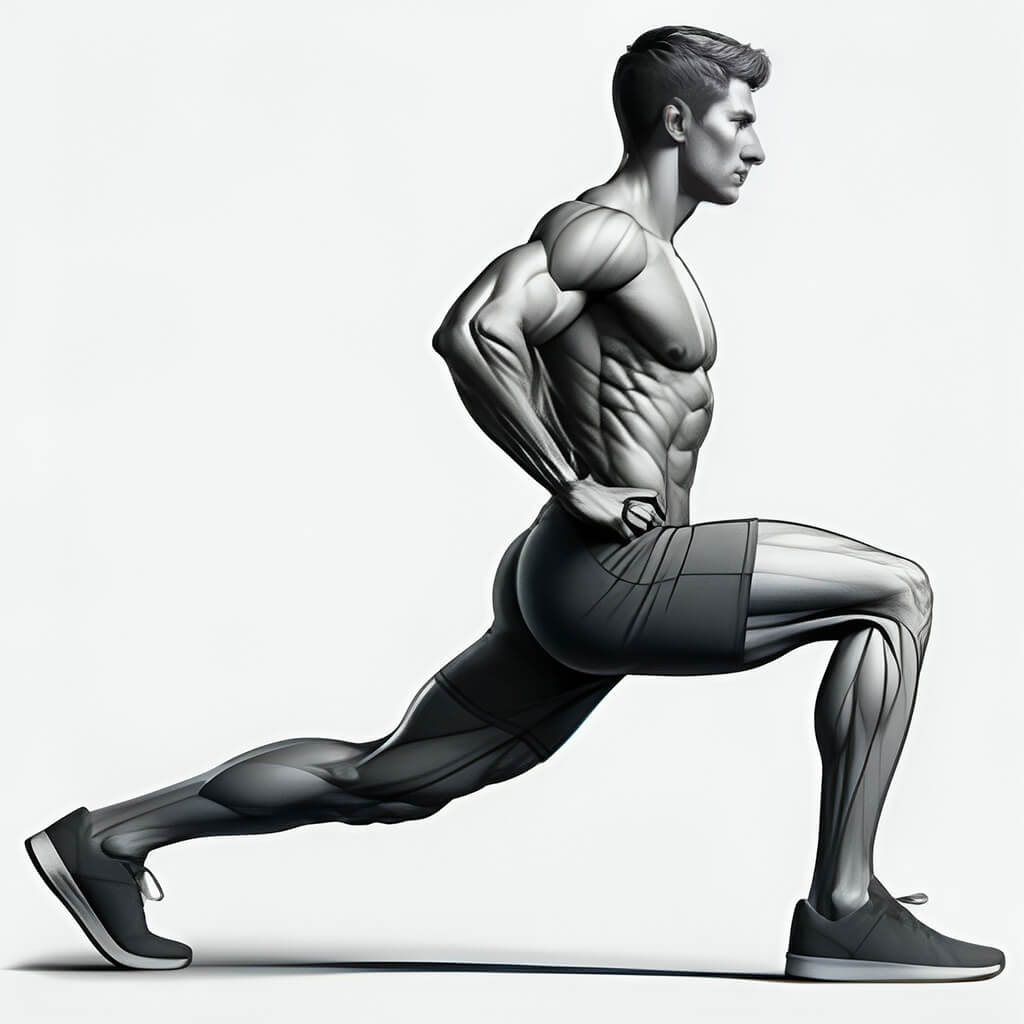
Step one foot forward into a lunge position, keeping the back leg straight. Sink into the stretch to target the calf muscles.
- Step 1: Stand upright with your shoulders down and your back straight.
- Step 2: Place your hands on your hips and engage your core. You can also hold onto a sturdy table or counter if you have balance issues.
- Step 3: Take a giant step — about 2-3 ft — forward with your right leg.
- Step 4: Bend your right knee to a 90-degree angle as you lower your body. Your right knee should not hover past your toes.
- Step 5: Feel the stretch in your left calf as you lower into the lunge. Press the ball of your left foot into the floor to deepen the stretch.
- Step 6: Hold the lunge for 15-30 seconds before you stand and return to the starting position.
- Step 7: Repeat 2-4 times before switching to your left leg.
Heel Drop
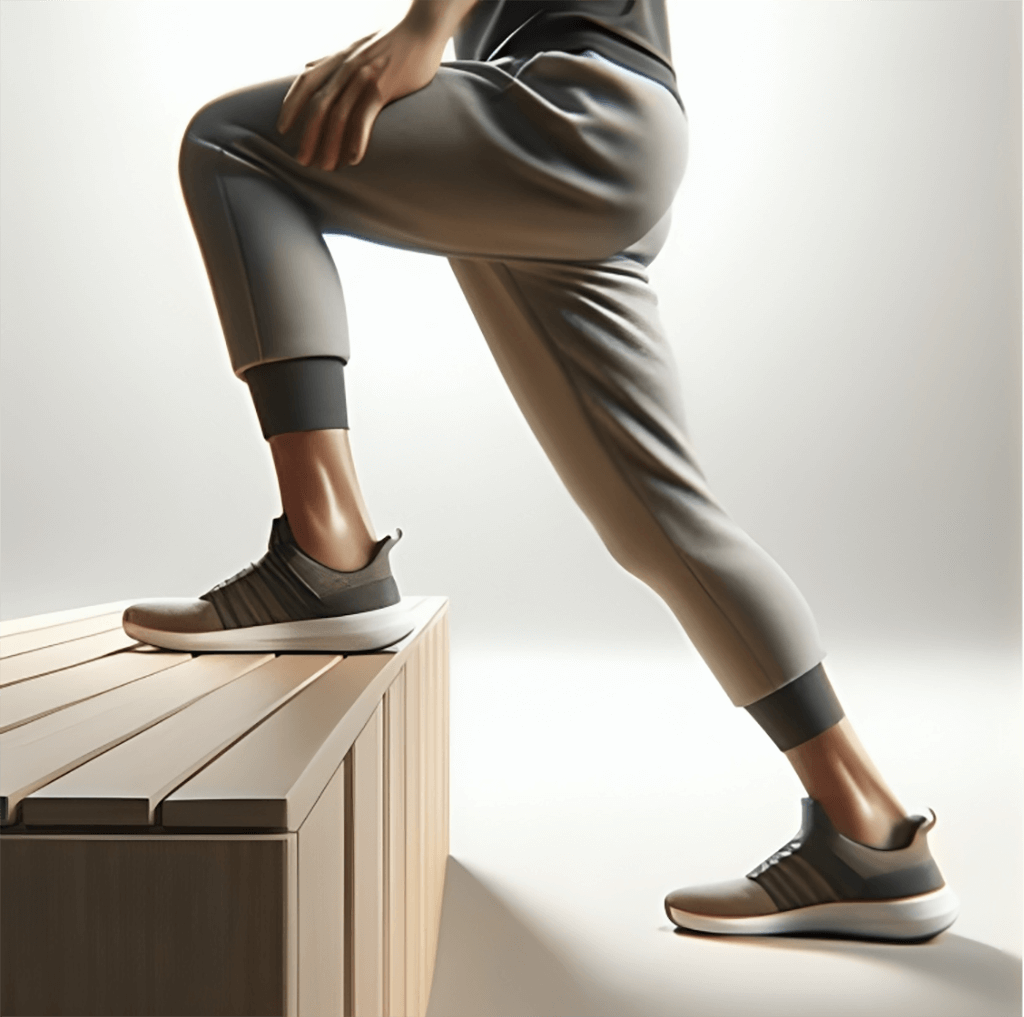
Stand on a raised surface with your heels hanging off the edge. Gently lower your heels below the level of the surface to stretch the calves.
Seated calf stretch with a resistance band
This seated calf stretch targets your hamstrings and shin. And using a resistance band deepens the stretch.
- Step 1: Sit on the floor with your legs extended straight in front of you.
- Step 2: Loop a resistance band around the ball of one foot. Hold one end of the resistance band in each hand.
- Step 3: Gently pull the resistance band toward your body, keeping your torso upright and your core engaged.
- Step 4: Hold the stretch for 30 seconds. Then, repeat on the other leg.
Standing bent-over calf stretch
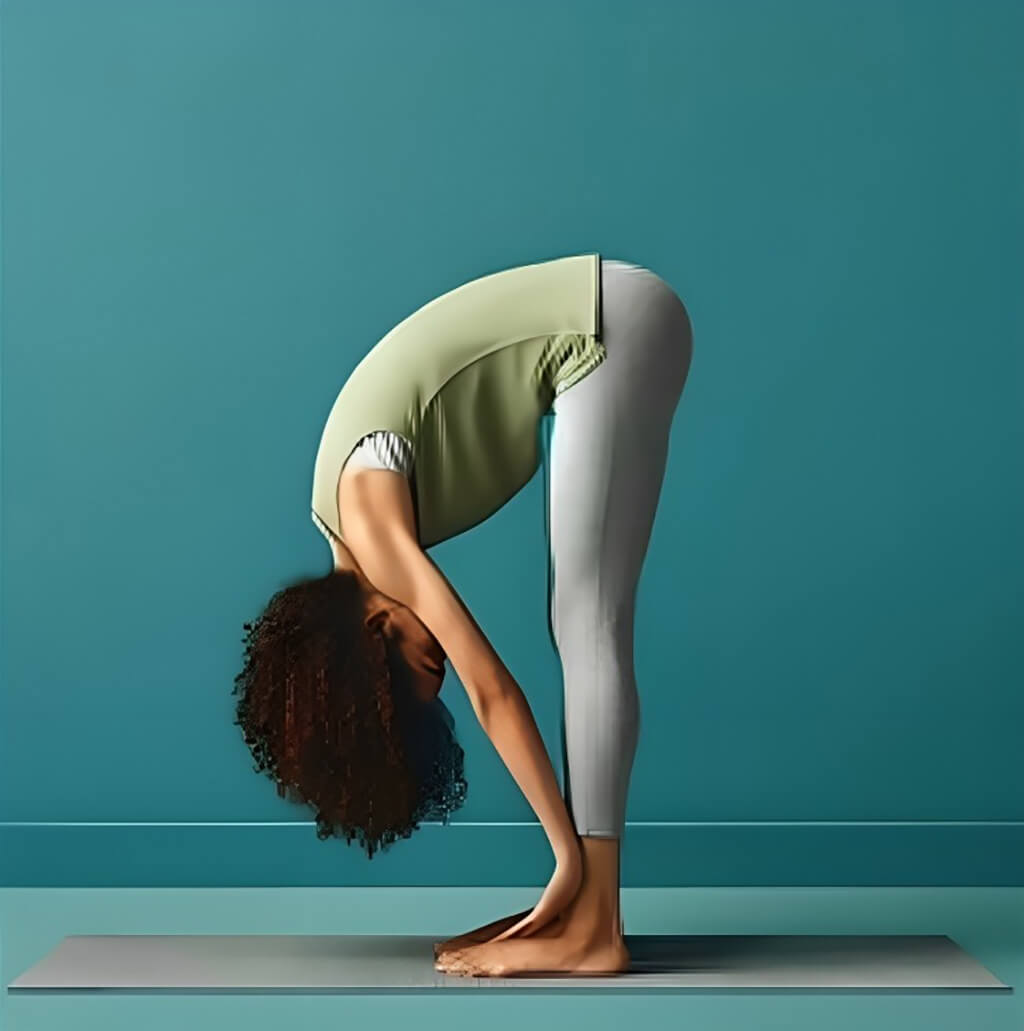
This standing calf stretch requires balance and flexibility in your hamstrings and lower back. So beginners should ease into this move.
- Step 1: Start in a split stance with your right foot about 1 ft in front of your left foot. Your feet should be staggered, not directly in front of each other.
- Step 2: Keep your right leg straight as you bend your left knee and fold forward from your hips.
- Step 3: Grab your right foot, just under your toes. Pull your toes up gently until you feel the stretch in your right calf.
- Step 4: Hold for 20-30 seconds.
- Step 5: Repeat on the other side.
Wall calf stretch

The wall calf stretch lengthens the muscles and connective tissues in the back of your legs.
- Step 1: Stand about 1 ft in front of a wall with your feet parallel to each other.
- Step 2: Place your palms on the wall at shoulder level.
- Step 3: Step your left foot back, keeping your leg straight and your heel on the floor.
- Step 4: Press into the wall as you bend your right knee. You should feel a good stretch in your left calf.
- Step 5: Hold for 15-30 seconds, then switch sides and repeat.
Soleus stretch
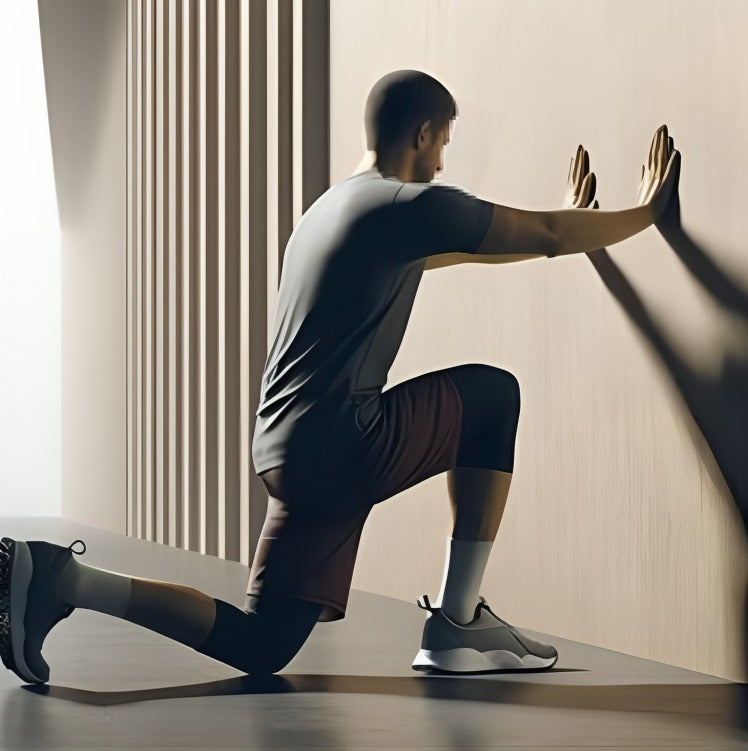
At first glance, the wall calf stretch and soleus stretch might look the same. But with the soleus stretch, you bend both knees. This allows you to isolate the soleus, which is the smaller of the two main calf muscles.
- Step 1: Stand about 1 ft in front of a wall with your feet parallel to each other.
- Step 2: Place your palms on the wall at shoulder level.
- Step 3: Step your right foot back, keeping both heels flat on the floor and your toes pointed toward the wall.
- Step 4: Bend your knees and lean toward the wall.
- Step 5: Hold for 15-30 seconds, feeling the stretch in the back of your right leg.
- Step 6: Repeat with your left leg stepping back.
Follow Up With Strategic Stretching
For a strategic approach to stretching out tight calves, consider Castleflexx’s easy-to-use stretching equipment!
Perfect for stretching the lower and upper body, as well as performing active and passive forms of stretching, this versatile piece of stretching equipment is a must when addressing tight calves. Assisted stretching is beneficial in targeting the muscles for a deeper stretch that could otherwise not be obtained on your own. And this tool allows you to achieve these benefits, like an improved range of motion and joint health, without requiring another person’s help!
Using Castleflexx’s guided stretches, like the 10 Degree Stretch and 90 Degree Stretch, you can achieve relief from tight calf muscles. This stretching tool can be used anywhere thanks to its easy portability. This assisted stretching equipment can benefit you if you struggle with frequent tightness in the calves or other muscles.
Finish With Other Recovery Efforts - Like an Epsom Salt Bath or CBD
An Epsom salt bath and CBD are two other beneficial recovery efforts that can help reduce tightness in the calves.
Epsom salt breaks down into sulfate and magnesium when placed in hot water. When you take an Epsom salt bath, your body absorbs these minerals to relax muscles and reduce inflammation. To use Epsom salt for tight muscles, add two cups of Epsom salt to a standard-size bathtub. The water should be hot or warm so the Epsom salt can dissolve quickly into the water.
CBD is another great tool to target tight muscles. It functions as a natural muscle relaxer while also reducing stress, helping to reduce symptoms of muscle tightness like soreness and cramping. There are many ways to achieve the benefits of CBD, as it comes in many forms, like bath bombs, gummies, extracts, etc.
How Long Does it Take Calf Tightness to Go Away?
For some, relief from calf tightness can come immediately. However, for those that suffer from consistent muscle tightness, this may need to be frequently addressed with the various recommended methods, like assisted stretching and deep massage work, to release tension in the area.
There may be a lifestyle factor causing the tightness that needs to be addressed to eliminate the issue completely. If the lifestyle issue cannot be addressed, then adding efforts like stretching into your weekly routine to relieve tension in the calves will be required.
How Tight Calves Affect the Body
- Impact on Gait: Tight calves can alter your walking pattern, affecting the alignment of the feet, ankles, and knees.
- Increased Injury Risk: Imbalances caused by tight calves may lead to injuries in the ankles, knees, and hips.
- Poor Posture: Tight calves can contribute to poor posture, leading to discomfort in the lower back and pelvis.
- Limited Range of Motion: Restricted ankle flexibility from tight calves can limit your overall range of motion.
Addressing and preventing tight calves through a combination of stretching, proper footwear, and self-care practices is essential for maintaining overall muscle health and preventing related issues.
Castleflexx’s stretching equipment provides a convenient solution for assisted stretching to enhance flexibility and relieve calf tightness. Invest in your muscle health today to enjoy a more comfortable and active lifestyle!
Preventing Tight Calves
To keep your calf muscles flexible and comfortable, it's important to follow a few key practices:
- Regular Stretching Routine: Integrate calf stretching into your daily schedule to enhance flexibility and prevent tightness. Simple exercises like standing calf raises or the downward dog pose can effectively stretch these muscles, reducing the risk of discomfort.
- Proper Footwear: Choosing the right footwear is crucial, especially for physical activities. Shoes with adequate arch support and cushioning distribute weight evenly, minimising strain on your calves. It's advisable to seek professional advice to find shoes that suit your foot shape and activity level.
- Hydration: Staying well-hydrated is essential for muscle health. Muscle cramps and stiffness often result from dehydration. Aim to drink at least eight glasses of water daily, adjusting based on your activity levels and the climate. After intense exercise, consider drinks that replenish electrolytes to maintain mineral balance and prevent muscle tightness.
Adhering to these strategies can help maintain your calves in good condition, ensuring ease of movement and reducing the risk of tightness.
Final Thoughts on How to Release Tight Calves
Several effective methods for releasing tight calves include deep massage work, assisted stretching, and warming up the muscles. Castleflexx’s stretching equipment enables you to perform assisted stretching on your own to achieve a deeper stretch to relish the pain relief and benefits. This portable, easy-to-use stretching tool is perfect if you’re on the go and suffer from tight muscles. So you don’t have to suffer from tight, cramping, sore muscles.
Buy Castleflexx’s assisted stretching tool today to achieve relief from muscle tightness!
